Experiment and Numerical Simulation on Hydraulic Loss and Flow Pattern of Low Hump Outlet Conduit with Different Inlet Water Rotation Speeds
Abstract
:1. Introduction
2. Research Object and Method
2.1. Geometrical Parameters and Research Methods
2.2. Mathematical Model and Numerical Computational Method
2.2.1. Mathematical Model
2.2.2. Computational Domains and Boundary Conditions
2.2.3. Mesh Generation and Calculation Setting
2.3. Validation of Numerical Simulation Results
2.4. Device of Model Test
3. Results and Analysis
3.1. Results and Analysis of Numerical Calculation
3.2. Results and Analysis of Model Test
4. Conclusions
- (1)
- With the growing inlet water rotation speed in the low hump outlet conduit, the hydraulic loss of the conduit is firstly decreased gradually and then obviously increased. The reasons for the above results are as below: when the hydraulic loss is increased arising from growing flow rotation speed, the hydraulic loss is reduced arising from improving flow pattern. If the increased hydraulic loss is less than the reduced hydraulic loss, the hydraulic loss of the outlet conduit will decrease. On the contrary, the hydraulic loss will increase.
- (2)
- The flow pattern in the low hump outlet conduit is greatly influenced by the inlet water rotation speed, with the increase in the inlet water rotation speed, the location of the main flow area and vortex area will correspondingly change. When the inlet water rotation speed is 0 r/min, the bottom of the descending segment is covered with a symmetrical vortex. When the inlet water rotation speed is increased, the position of the vortex transfers to the lower right side of the conduit descends the segment, and the range of the vortex area is gradually decreased. While inlet water rotation speed grows to 400 r/min, the vortex field in the outlet conduit is inexistent.
- (3)
- The inlet water rotation speed of the low hump outlet conduit has a great impact on both hydraulic loss and flow pattern. The guide vane in the low head pump cannot completely eliminate the rotation speed of the water transmitted from the pump impeller. Therefore, the factor of the rotation speed of flow must be considered in the hydraulic optimum design of the outlet conduit, so that the hydraulic performance of the outlet conduit is optimized under the condition of a certain rotation speed.
- (4)
- The research results of this paper also have certain guiding functions to the hydraulic design of the guide vane in the low head pump, it is suggested that the guide vane is designed according to the flow rotation speed under which the hydraulic performance of the outlet conduit is optimal, so as to achieve the optimal matching between guide vane and outlet conduit in low head pump device. From the design of the guide vane in the low head pump, the numbers of blades in the guide vane of the existing low head pumps are mainly between five and seven [57], which is to ensure that the rotation speed of the water at the outlet conduit is not too large.
Author Contributions
Funding
Institutional Review Board Statement
Informed Consent Statement
Data Availability Statement
Conflicts of Interest
Nomenclature
| Empirical coefficient | |
| Time-averaged strain rate, s−1 | |
| Gravity force, N | |
| Turbulent kinetic energy item, kg/(m·s3) | |
| Hydraulic loss between inlet section of outlet conduit and cross-section 2-2, m | |
| Hydraulic loss between cross-section 1-1 and inlet section of outlet conduit, m | |
| Hydraulic loss of outlet conduit, m | |
| Piezometer head of cross-section 1-1, m | |
| Piezometer head of cross-section 2-2, m | |
| Turbulent Intensity | |
| Turbulent kinetic energy, m2/s2 | |
| Rotation speed, r/min | |
| Normal physical parameters | |
| Pressure, Pa | |
| Average pressure, Pa | |
| Fluctuant pressure, Pa | |
| Fluctuant pressure, Pa | |
| Inside radius of conduit inlet cross-section, m | |
| Outside radius of conduit inlet cross-section, m | |
| Equivalent radius of conduit inlet cross-section, m | |
| Reynolds number | |
| Swirl number | |
| Radius of the point in conduit inlet cross-section, m | |
| Time, s | |
| Velocity component, m/s | |
| Average velocity component, m/s | |
| Fluctuant velocity component, m/s | |
| Normal velocity of boundary, m/s | |
| Normal velocity of water near wall, m/s | |
| Circular velocity in inlet section of outlet conduit, m/s | |
| Tangential velocity of water near wall, m/s | |
| Tangential velocity of wall, m/s | |
| Normal velocity of water near wall, m/s | |
| Dimensionless distance | |
| Axial velocity in conduit inlet cross-section, m/s | |
| Tangential velocity in conduit inlet cross-section, m/s | |
| Mean velocity of cross-section 1-1, m/s | |
| Mean velocity of cross-section 2-2, m/s | |
| Mean inlet velocity of outlet conduit, m/s | |
| Mean outlet velocity of outlet conduit, m/s | |
| Coordinate direction | |
| Normal direction | |
| Dimensionless velocity | |
| Empirical coefficient | |
| Empirical coefficient | |
| Kronecker delta | |
| Turbulent dissipation rate, % | |
| , | Empirical coefficient |
| Kinetic energy recovery coefficient | |
| Dynamic viscosity, kg/(m·s) | |
| Turbulent viscosity, kg/(m·s) | |
| Angle revolving around the rotation axis in conduit inlet section, ° | |
| Density, kg/m3 | |
| Wall shear stress, Pa | |
| Angular velocity, rad/s |
References
- Lu, L.G. Optimized Hydraulic Design of Large-Scale High-Performance Pump Device with Low Head, 1st ed.; China Water & Power Press: Beijing, China, 2013. (In Chinese) [Google Scholar]
- Lu, L.G.; Liu, J.; Liang, J.D.; Xu, L.; Huang, J.J.; Liu, R.H. Numerical simulation of 3D turbulent flow and hydraulic loss in outlet conduit of large pumping station. Drain. Irrig. Mach. 2008, 26, 51–54. (In Chinese) [Google Scholar]
- Qiu, B.Y.; Lin, H.J.; Yuan, S.Q.; Huang, J.Y.; Feng, X.L. Optimum hydraulic design for discharge passage of large pump. Chin. J. Mech. Eng. 2006, 42, 47–51. (In Chinese) [Google Scholar] [CrossRef]
- Karpenko, M.; Prentkovskis, O.; Sukevicius, S. Research on high-pressure hose with repairing fitting and influence on energy parameter of the hydraulic drive. Eksploat. Niezawodn.—Maint. Reliab. 2022, 24, 25–32. [Google Scholar] [CrossRef]
- Ge, M.M.; Manikkam, P.; Ghossein, J.; Subramanian, R.K.; Coutier-Delgosha, O.; Zhang, G.J. Dynamic mode decomposition to classify cavitating flow regimes induced by thermodynamic effects. Energy 2022, 254, 124426. [Google Scholar] [CrossRef]
- Ge, M.M.; Sun, C.Y.; Zhang, G.J.; Coutier-Delgosha, O.; Fan, D.X. Combined suppression effects on hydrodynamic cavitation performance in Venturi-type reactor for process intensification. Ultrason. Sonochemistry 2022, 86, 106035. [Google Scholar] [CrossRef]
- Ge, M.M.; Zhang, G.J.; Petkovšek, M.; Long, K.P.; Coutier-Delgosha, O. Intensity and regimes changing of hydrodynamic cavitation considering temperature effects. J. Clean. Prod. 2022, 338, 130470. [Google Scholar] [CrossRef]
- Ge, M.M.; Petkovšek, M.; Zhang, G.J.; Jacobs, D.; Coutier-Delgosha, O. Cavitation dynamics and thermodynamic effects at elevated temperatures in a small Venturi channel. Int. J. Heat Mass Transf. 2021, 170, 120970. [Google Scholar] [CrossRef]
- McDonald, A.T.; Fox, R.W.; Van Dewoestine, R.V. Effect of swirling flow on pressure recovery in conical diffusers. AIAA J. 1971, 9, 2014–2018. [Google Scholar] [CrossRef]
- Prakash, R.; Karthiek, N.; Ashwath, P.; Anand, H.; Adithya, G. Numerical study on a conical diffuser with inlet swirl. Appl. Mech. Mater. 2016, 852, 688–692. [Google Scholar]
- Kaya, D. Experimental study on regaining the tangential velocity energy of axial flow pump. Energy Convers. Manag. 2003, 44, 1817–1829. [Google Scholar] [CrossRef]
- Susan-Resiga, R.; Ciocan, G.D.; Anton, I.; Avellan, F. Analysis of the Swirling Flow Downstream a Francis Turbine Runner. J. Fluids Eng. 2005, 128, 177–189. [Google Scholar] [CrossRef]
- Qiu, B.Y.; Huang, J.Y.; Yuan, S.Q.; Lin, H.J.; Feng, X.L.; Gao, C.H. Study on determination of water flow energy in section of outlet pipe of an axial flow pump. J. Hydroelectr. Eng. 2005, 24, 104–109. (In Chinese) [Google Scholar]
- Liang, J.D.; Lu, L.G.; Xu, L.; Chen, W.; Wang, G. Influence of flow velocity circulation at guide vane outlet of axial-flow pump on hydraulic loss in outlet conduit. Trans. CSAE 2012, 28, 55–60. (In Chinese) [Google Scholar]
- Qiu, B.Y.; Feng, X.L.; Yuan, S.Q. Analysis of flow deviation in two-channel discharge passage of a large pumping station. J. Hydroelectr. Eng. 2005, 24, 110–114. (In Chinese) [Google Scholar]
- Qiu, B.Y.; Huang, J.Y.; Yuan, S.Q.; Lin, H.J.; Huang, J.Y. Test investigation on hydraulic losses in discharge passage of axial-flow pump. Chin. J. Mech. Eng. 2006, 42, 39–44. (In Chinese) [Google Scholar] [CrossRef]
- Zhu, H.G. Numerical analysis on the internal flow of siphon discharge passages under off-design conditions. J. Hydroelectr. Eng. 2006, 25, 140–144. (In Chinese) [Google Scholar]
- Zhu, H.G.; Yuan, S.Q. Performance effect of inlet flow field on siphon outlet conduit. Trans. Chin. Soc. Agric. Mach. 2006, 37, 193–196. (In Chinese) [Google Scholar]
- Cai, J.L. Study on the Numerical Simulation of the Influence of the Outlet Circulation of Axial Flow Pump to the Hydraulic Loss of the Outlet Conduit. Master’s Thesis, Yangzhou University, Yangzhou, China, 2009. (In Chinese). [Google Scholar]
- Fang, G.H.; Zhu, X.H.; Huang, X.F. Risk analysis of floodwater resources utilization along water diversion project: A case study of the Eastern Route of the South-to-North Water Diversion Project in China. Water Supply 2019, 19, 2464–2475. [Google Scholar] [CrossRef]
- Lu, L.G.; Wu, K.P.; Leng, Y.; Chen, A.P. Hydraulic optimization design on straight outlet conduit of large-scale pumping station with low head. Trans. Chin. Soc. Agric. Mach. 2007, 38, 196–198. (In Chinese) [Google Scholar]
- Wang, H.L.; Long, B.; Wang, C.; Han, C.; Li, L. Effects of the impeller blade with a slot structure on the centrifugal pump performance. Energies 2020, 13, 1628. [Google Scholar] [CrossRef]
- Luo, H.; Zhou, P.; Shu, L.; Mou, J.; Zheng, H.; Jiang, C.; Wang, Y. Energy Performance Curves Prediction of Centrifugal Pumps Based on Constrained PSO-SVR Model. Energies 2022, 15, 3309. [Google Scholar] [CrossRef]
- Zhou, P.J.; Dai, J.C.; Yan, C.S.; Zheng, S.H.; Ye, C.L.; Zhang, X. Effect of stall cells on pressure fluctuations characteristics in a centrifugal pump. Symmetry 2019, 11, 1116. [Google Scholar] [CrossRef] [Green Version]
- Sun, Z.Z.; Wang, X.Y.; Shi, L.J.; Tang, F.P. Hydraulic performance and flow patterns of axial-flow pumps with axial stacking of different airfoil series. J. Drain. Irrig. Mach. Eng. 2022, 40, 217–222. (in Chinese). [Google Scholar]
- Song, Y.; Gu, X.Y.; Liu, Y.Y.; Yin, J.L.; Wang, D.Z. Numerical simulation on pressure pulsation characteristic of nuclear coolant pump under different boundary conditions. J. Drain. Irrig. Mach. Eng. 2019, 37, 645–649. (In Chinese) [Google Scholar]
- Xu, L.; Xia, B.; Shi, W.; Liu, J.; Yan, S.K.; Lu, L.G. Influence of middle pier lengths on hydraulic characteristic of outlet conduit in pump system with slanted extension shaft. Trans. Chin. Soc. Agric. Eng. 2020, 36, 74–81. (In Chinese) [Google Scholar]
- Jiang, H.Y.; Yan, H.Q.; Xiao, Z.M.; Cheng, L.; Liu, H. Numerical simulation of hydraulic characteristics of three-side inlet of vertical shaft inlet channel of horizontal pumping station. J. Drain. Irrig. Mach. Eng. 2021, 39, 1008–1013. (In Chinese) [Google Scholar]
- Tong, Z.M.; Yang, Z.Q.; Huang, Q.; Yao, Q. Numerical Modeling of the hydrodynamic performance of slanted axial-flow urban drainage pumps at shut-off condition. Energies 2022, 15, 1905. [Google Scholar] [CrossRef]
- Lu, W.G.; Wang, D.W.; Shi, W.; Liu, J.; Xu, L. Comparison of hydraulic performance between submersible tubular pump device with motor front and rear arrangements. J. Drain. Irrig. Mach. Eng. 2020, 38, 325–331. (In Chinese) [Google Scholar]
- Shi, W.; Cheng, L. Analysis of effect of blades angle on hydraulic performance for pumping system of water diversion pumping station. J. Drain. Irrig. Mach. Eng. 2020, 38, 372–377. (In Chinese) [Google Scholar]
- Teuber, K.; Broecker, T.; Bayón, A.; Nützmann, G.; Hinkelmann, R. CFD-modelling of free surface flows in closed conduits. Prog. Comput. Fluid Dyn. 2019, 6, 368–380. [Google Scholar] [CrossRef]
- Simão, M.; Pérez-Sánchez, M.; Carravetta, A.; López-Jiménez, P.; Ramos, H.M. Velocities in a Centrifugal PAT Operation: Experiments and CFD Analyses. Fluids 2018, 3, 3. [Google Scholar] [CrossRef] [Green Version]
- Rezvaya, K.; Krupa, E.; Shudryk, A.; Drankovskiy, V. Solving the hydrodynamical tasks using CFD programs. In Proceedings of the International Conference on Intelligent Energy and Power Systems, Kharkiv, Ukraine, 10–14 September 2018; pp. 205–209. [Google Scholar]
- Gunjo, D.G.; Mahanta, P.; Robi, P.S. CFD and experimental investigation of flat plate solar water heating system under steady-state condition. Renew. Energy 2017, 106, 24–36. [Google Scholar] [CrossRef]
- Seyedashraf, O.; Akhtari, A.A. Three-dimensional CFD study of free-surface flow in a sharply curved 30° open-channel bend. J. Eng. Sci. Technol. Rev. 2017, 10, 85–89. [Google Scholar] [CrossRef]
- Ziaei, A.N.; Nikou, N.S.; Beyhaghi, A.; Beyhaghi, F.; Khodashenas, S.R. Flow simulation over a triangular labyrinth side weir in a rectangular channel. Prog. Comput. Fluid Dyn. 2019, 19, 22–34. [Google Scholar] [CrossRef]
- Zhou, P.J.; Yan, C.S.; Shu, L.F.; Wang, H.; Mou, J.G. Effects of particle concentration on the dynamics of a single-channel sewage pump under low-flow-rate condition. FDMP-Fluid Dyn. Mater. Process. 2021, 17, 871–886. [Google Scholar] [CrossRef]
- Adhikari, R.; Wood, D. Computational Analysis of a Double-Nozzle Crossflow Hydroturbine. Energies 2018, 11, 3380. [Google Scholar] [CrossRef] [Green Version]
- Zhang, D.; Wang, H.; Liu, J.; Wang, C.; Ge, J.; Zhu, Y.; Chen, X.; Hu, B. Flow characteristics of oblique submerged impinging jet at various impinging heights. J. Mar. Sci. Eng. 2022, 10, 399. [Google Scholar] [CrossRef]
- Hu, B.; Wang, H.; Liu, J.; Zhu, Y.; Wang, C.; Ge, J.; Zhang, Y. A numerical study of a submerged water jet impinging on a stationary wall. J. Mar. Sci. Eng. 2022, 10, 228. [Google Scholar] [CrossRef]
- Yakhot, V.; Orszag, S.A. Renormalization group analysis of turbulence. I. basic theory. J. Sci. Comput. 1986, 1, 3–51. [Google Scholar] [CrossRef] [Green Version]
- Wang, F.J. Computational Fluid Dynamics Analysis—Principle and Application, 1st ed.; Tsinghua University Press: Beijing, China, 2004. (In Chinese) [Google Scholar]
- Ibrahim, K.A.; Hamed, M.H.; El-Askary, W.A.; El-Behery, S.M. Swirling gas–solid flow through pneumatic conveying drye. Powder Technol. 2013, 235, 500–515. [Google Scholar] [CrossRef]
- Shi, L.J.; Yuan, Y.; Jiao, H.F.; Tang, F.P.; Chen, L.; Yang, F.; Jin, Y.; Zhu, J. Numerical investigation and experiment on pressure pulsation characteristics in a full tubular pump. Renew. Energy 2021, 163, 987–1000. [Google Scholar] [CrossRef]
- Stachnik, M.; Jakubowski, M. Multiphase model of flow and separation phases in a whirlpool: Advanced simulation and phenomena visualization approach. J. Food Eng. 2020, 274, 109846. [Google Scholar] [CrossRef]
- Rodi, W. Turbulence Models and Their Application in Hydraulics: A State of the-Art Review, 3rd ed.; Balkema: Rotterdam, The Netherlands, 2017. [Google Scholar]
- Ariff, M.; Salim, S.M.; Cheah, S.C. Wall y+ approach for dealing with turbulent flow over a surface mounted cube: Part 1—low Reynolds number. In Proceedings of the Seventh International Conference on CFD in the Minerals and Process Industries, Melbourne, VIC, Australia, 9–11 December 2009; pp. 1–6. [Google Scholar]
- Sterczyńska, M.; Jakubowski, M. Research on Particles’ Velocity Distribution in a Whirlpool Separator Using the PIV Method of Measurement. Int. J. Food Eng. 2017, 13, 20160316. [Google Scholar] [CrossRef]
- Sterczynsk, M.; Stachnik, M.; Poreda, A.; Piepiorka-Stepuk, J.; Zdaniewicz, M.; Jakubowsk, M. The improvement of flow conditions in a whirlpool with a modified bottom: An experimental study based on particle image velocimetry (PIV). J. Food Eng. 2021, 289, 110164. [Google Scholar] [CrossRef]
- ISO 9906-2012; Rotodynamic Pumps—Hydraulic Performance Acceptance Tests—Grades 1, 2 and 3. ISO: Geneva, Switzerland, 2012. (In Chinese)
- Lu, L.G.; Wu, K.P.; Leng, Y.; Zhu, J. Measurement for hydraulic loss of outlet conduit of pumping station. Drain. Irrig. Mach. 2005, 23, 23–26. (In Chinese) [Google Scholar]
- Lu, W.G.; Dong, L.; Wang, Z.F.; Lu, L.L. Cross influence of discharge and circulation on head loss of conduit of pump system with low head. Appl. Math. Mech. 2012, 33, 1533–1544. [Google Scholar] [CrossRef]
- Wu, C.G. Hydraulics, 5th ed.; Higher Education Press: Beijing, China, 2016. (In Chinese) [Google Scholar]
- Zhang, X.L.; Xiao, H.; Gomez, T.; Coutier-Delgosha, O. Evaluation of ensemble methods for quantifying uncertainties in steady-state CFD applications with small ensemble sizes. Comput. Fluids 2020, 203, 104530. [Google Scholar] [CrossRef] [Green Version]
- Ge, M.M.; Zhang, X.L.; Brookshire, K.; Coutier-Delgosha, O. Parametric and V&V study in a fundamental CFD process: Revisiting the lid-driven cavity flow. Aircr. Eng. Aerosp. Technol. 2022, 94, 515–530. [Google Scholar]
- Liu, N.; Wang, Y.S.; Zhang, G. Pump Model Test of South-to-North Water Diversion in Same Bench, 1st ed.; China Water & Power Press: Beijing, China, 2006. (In Chinese) [Google Scholar]
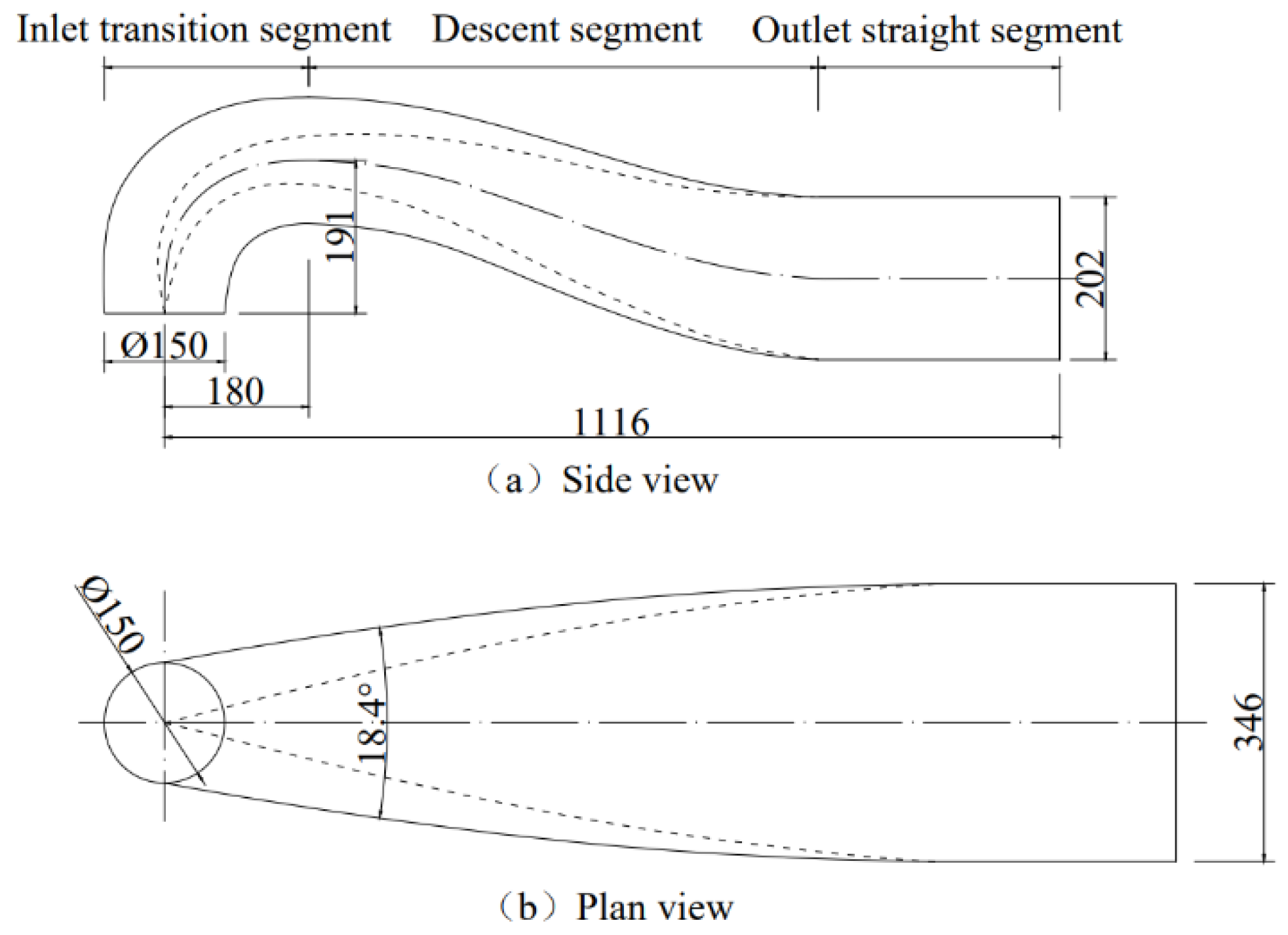

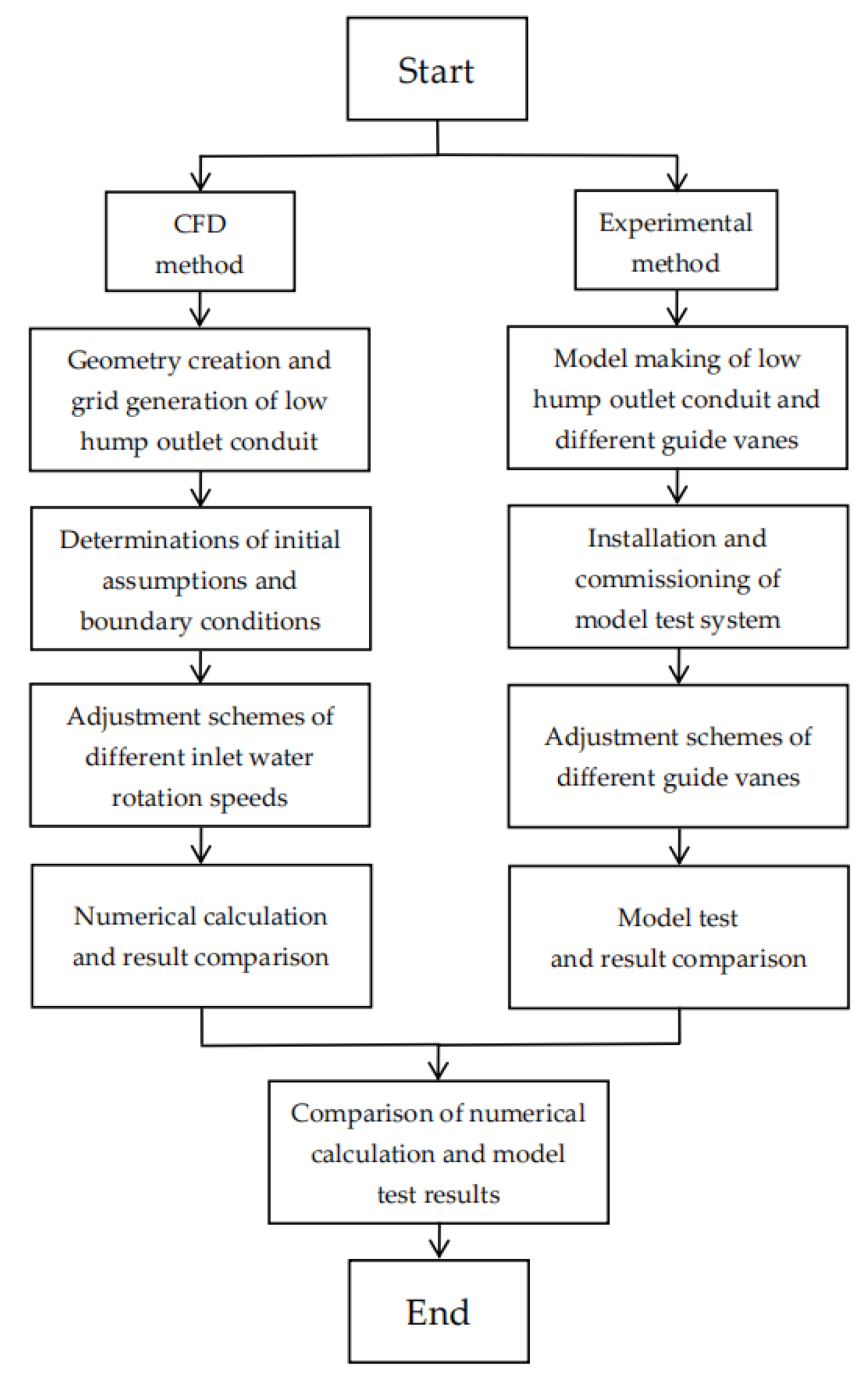

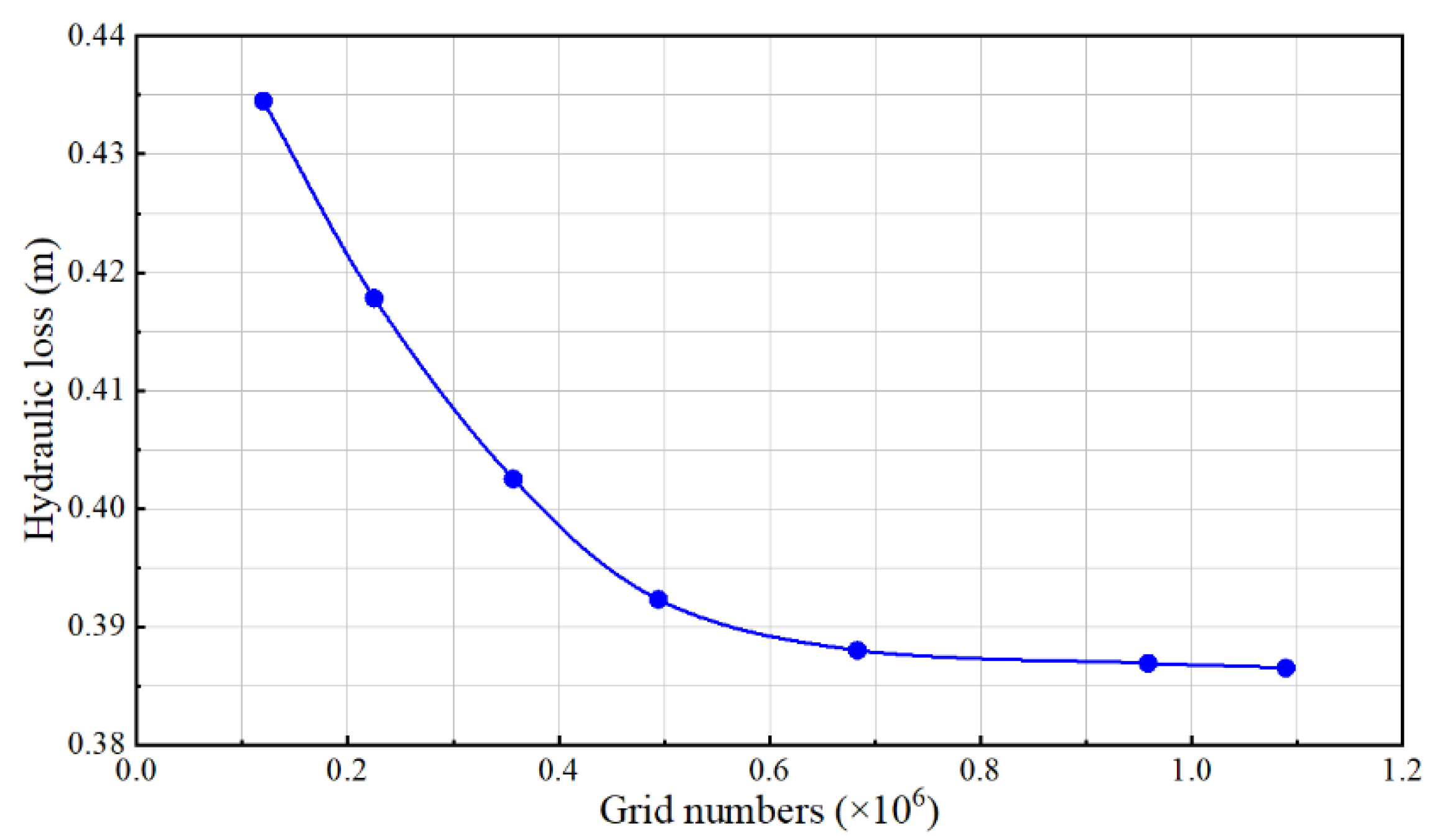

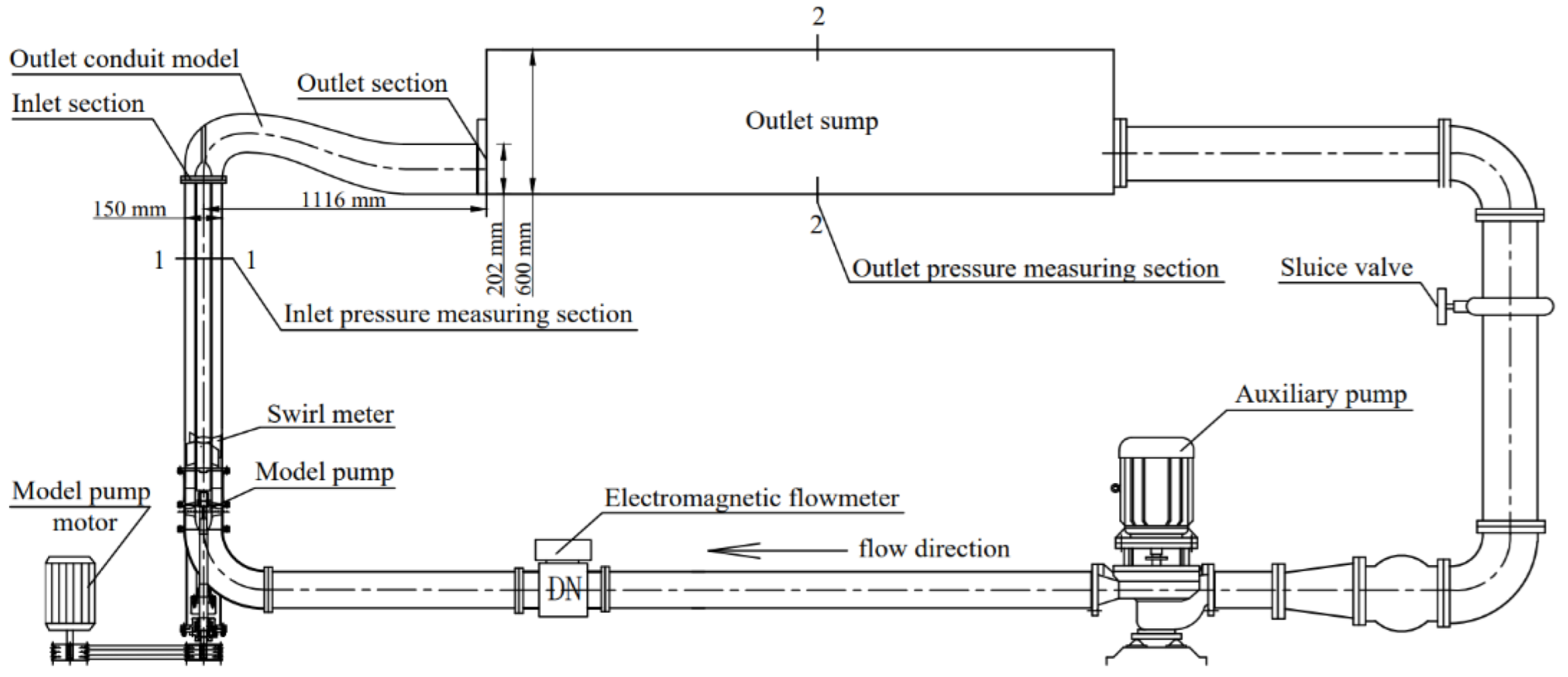


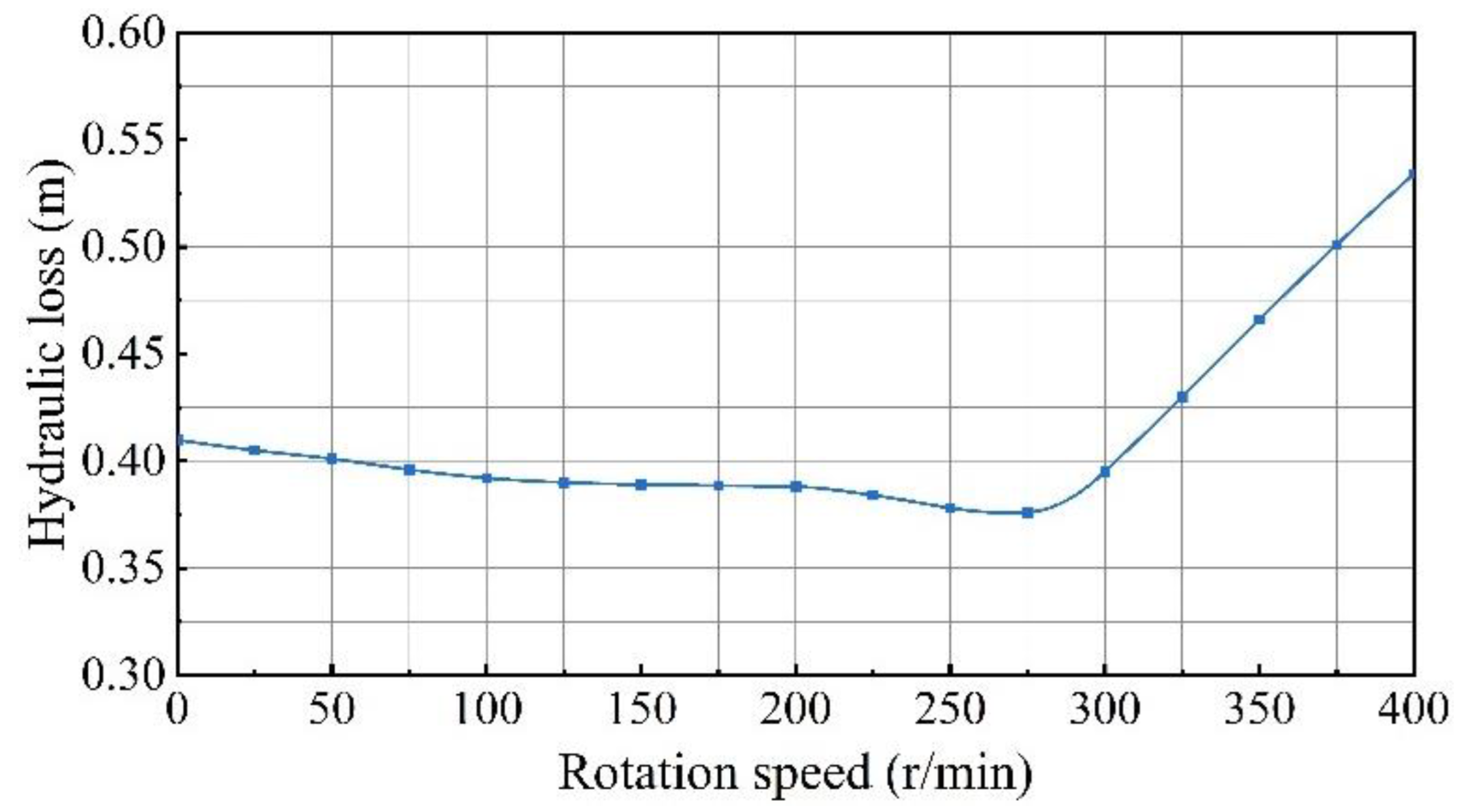
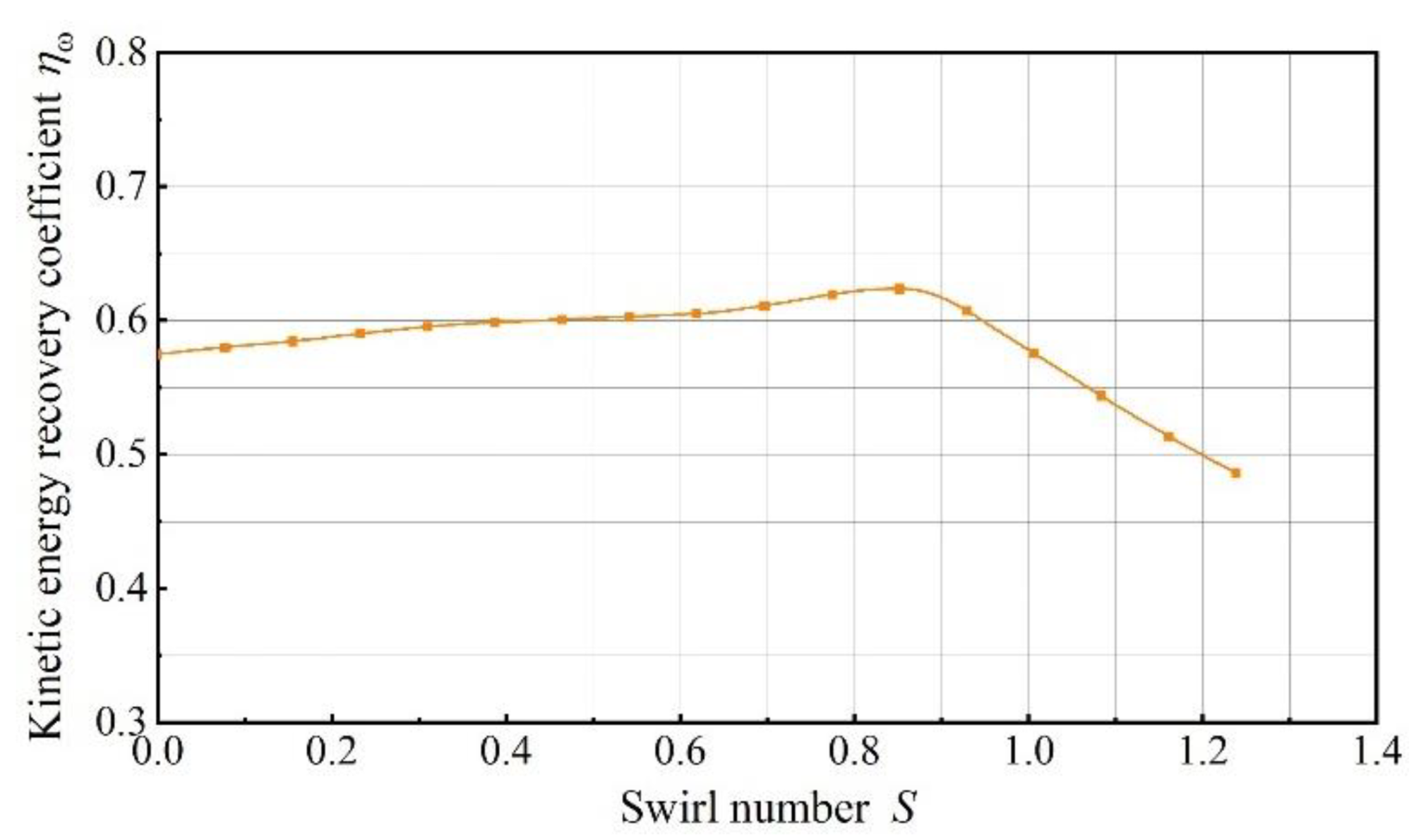

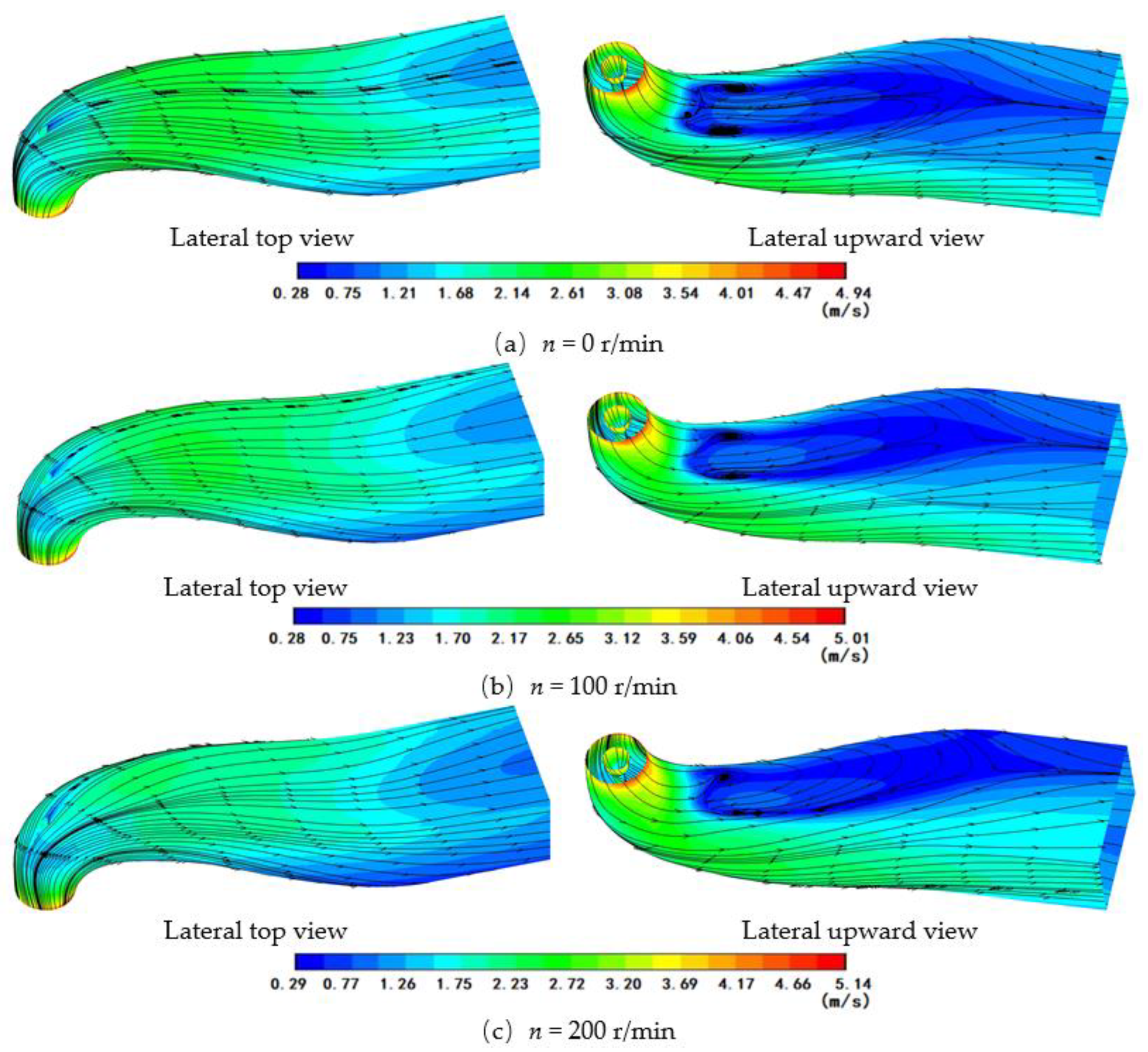


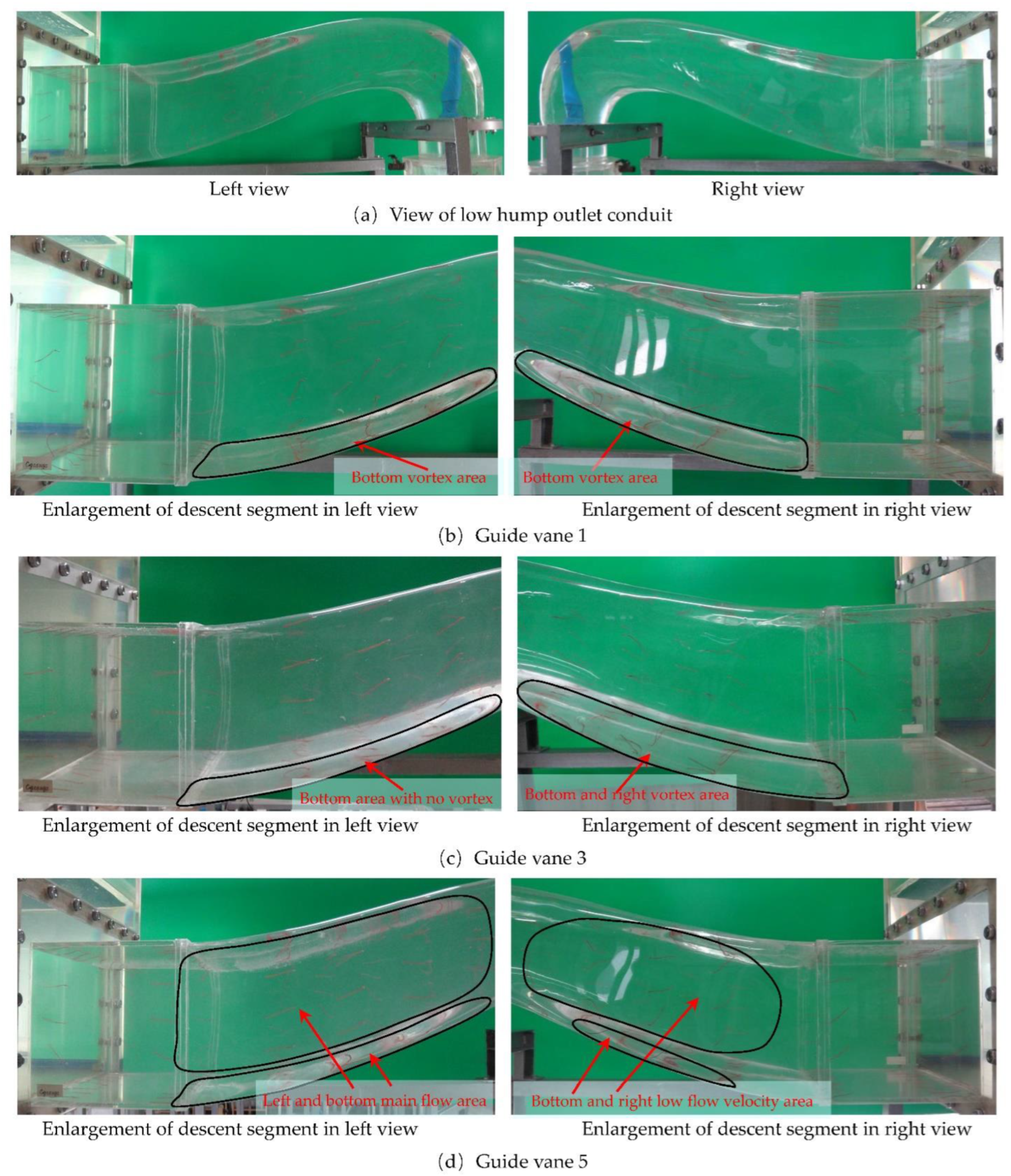
| Parameter | Value |
|---|---|
| Diameter of inlet section (mm) | 150 |
| Length of outlet conduit (mm) | 1116 |
| Length of inlet transition segment (mm) | 180 |
| Height of inlet transition segment (mm) | 191 |
| Diffusion angle of plane (°) | 18.4 |
| Width of outlet section (mm) | 346 |
| Height of outlet section (mm) | 202 |
| Domain | Inlet Straight Pipe | Low Hump Outlet Conduit | Outlet Sump |
|---|---|---|---|
| Grid number (×106) | 0.025 | 0.502 | 0.156 |
| Number of Guide Vane | Guide Vane 1 | Guide Vane 2 | Guide Vane 3 | Guide Vane 4 | Guide Vane 5 |
|---|---|---|---|---|---|
| Inlet water rotation speed (r/min) | 61 | 216 | 286 | 342 | 390 |
| Hydraulic loss of conduit (m) | 0.426 | 0.413 | 0.402 | 0.496 | 0.602 |
| Modified hydraulic loss of conduit (m) | 0.407 | 0.394 | 0.384 | 0.478 | 0.583 |
Publisher’s Note: MDPI stays neutral with regard to jurisdictional claims in published maps and institutional affiliations. |
© 2022 by the authors. Licensee MDPI, Basel, Switzerland. This article is an open access article distributed under the terms and conditions of the Creative Commons Attribution (CC BY) license (https://creativecommons.org/licenses/by/4.0/).
Share and Cite
Xu, L.; Jiang, T.; Wang, C.; Ji, D.; Shi, W.; Xu, B.; Lu, W. Experiment and Numerical Simulation on Hydraulic Loss and Flow Pattern of Low Hump Outlet Conduit with Different Inlet Water Rotation Speeds. Energies 2022, 15, 5371. https://doi.org/10.3390/en15155371
Xu L, Jiang T, Wang C, Ji D, Shi W, Xu B, Lu W. Experiment and Numerical Simulation on Hydraulic Loss and Flow Pattern of Low Hump Outlet Conduit with Different Inlet Water Rotation Speeds. Energies. 2022; 15(15):5371. https://doi.org/10.3390/en15155371
Chicago/Turabian StyleXu, Lei, Tao Jiang, Chuan Wang, Dongtao Ji, Wei Shi, Bo Xu, and Weigang Lu. 2022. "Experiment and Numerical Simulation on Hydraulic Loss and Flow Pattern of Low Hump Outlet Conduit with Different Inlet Water Rotation Speeds" Energies 15, no. 15: 5371. https://doi.org/10.3390/en15155371
APA StyleXu, L., Jiang, T., Wang, C., Ji, D., Shi, W., Xu, B., & Lu, W. (2022). Experiment and Numerical Simulation on Hydraulic Loss and Flow Pattern of Low Hump Outlet Conduit with Different Inlet Water Rotation Speeds. Energies, 15(15), 5371. https://doi.org/10.3390/en15155371







